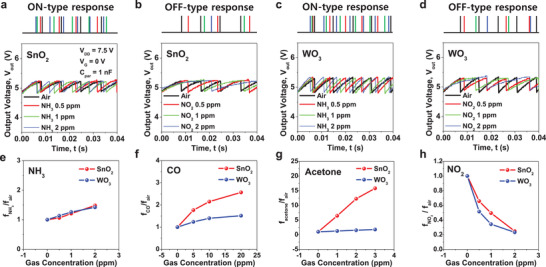Figure 4.

Spiking characteristics of artificial olfactory neuron modules. a,b) Spiking characteristics (V out–t) of the artificial olfactory neuron modules composed of the SnO2 gas sensor and the 1T‐neuron. Spiking was activated when the gas concentration of NH3 was increased (ON‐type response) and was depressed as the gas concentration of NO2 was increased (OFF‐type response). c,d) V out–t of the artificial olfactory neuron modules comprising WO3 gas sensor and the 1T‐neuron. Like the SnO2‐based neuron module, spiking was activated as the gas concentration of NH3 was increased (ON‐type response) and depressed when the gas concentration of NO2 was increased (OFF‐type response). e,h) Ratio (f gas/f air) for various concentrations of NH3, CO, acetone, and NO2, where the spiking frequency to gas species is f gas and that to air is f air. Spiking frequency of the artificial olfactory neuron modules was increased in the NH3, CO, and acetone environments (ON‐type response), while it was decreased in the NO2 environment (OFF‐type response).
